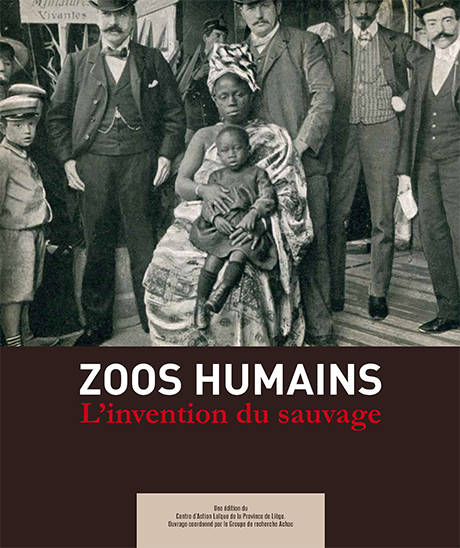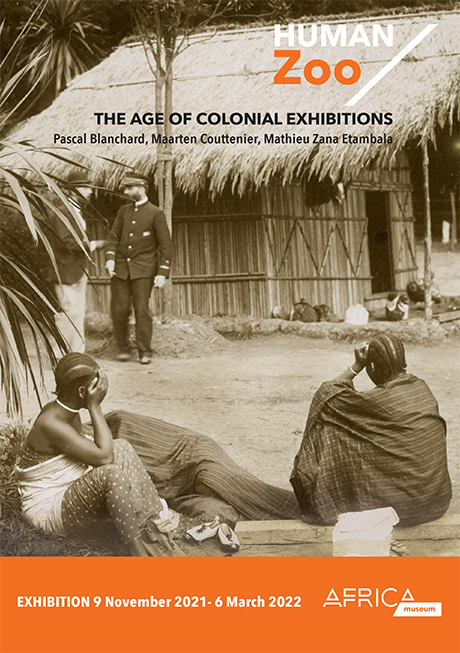Learn more
Publications

In 2016, an earlier and more targeted version of this travelling exhibition was held at the Cité Miroir in Liège.
That exhibition was accompanied by a catalogue entitled Zoos humains. L’Invention du sauvage. Its authors include P. Blanchard and M. Couttenier, curators of the current exhibition, as well as other contributors from the RMCA. Many of the themes and documents in the catalogue reflect the ones presented in Tervuren.
This richly illustrated coffee table book will be available in the AfricaShop.
For nearly five centuries (1490-1960), putting humans on exhibit would represent an industry that fascinated more than a billion and four hundred million visitors and involve between thirty and thirty-five thousand ‘exhibited persons’ all over the world. These spectacles, the first visual contact between cultures, marked a division and created a hierarchy between the so-called ‘civilized’ and ‘savage’ peoples of the world in the Western mind. The phenomenon saw a peak that began in the mid-19th century and would last until the 1950s, when it became an essential component of a veritable exhibition industry.
This book provides insights on the hows and whys of such displays in Western society and the consequences thereof. In Belgium, as in much of Western Europe, visitors came by the million between 1885 and 1958 to catch a glimpse of so-called ‘savages’ from all four corners of the world, including Belgian colonies, who were the players in the grand spectacle of Otherness and gave legitimacy to colonization.
Only in French - On sale at the AfricaShop and via the RMCA Publications service.
Hardcover, 84 pages, 24 X 28.5 cm - ISBN: 978-2-930845-04-3 - Retail price incl. taxes: 25 euros

This catalogue accompanies the exhibit Human zoo. The age of colonial exhibitions. After stops in Paris (Musée du quai Branly), Rouen (Muséum), Liège (Cité Miroir), and Point-à-Pitre (Mémorial ACTe), this travelling exhibition is presented at the Royal Museum for Central Africa in partnership with the Groupe de recherche Achac to mark 125 years since a colonial section was set up in Tervuren as part of the 1897 International Exhibition of Brussels.
Designed by historian Pascal Blanchard (Groupe de recherche Achac) and Maarten Couttenier and Mathieu Zana Etambala (RMCA), the exhibit takes the visitor back to the forgotten history of ‘human zoos’. While it puts the spotlight on Tervuren, the exhibit places the phenomenon of ‘ethnographic’ displays in a broader context. From the early 19th century up to the Second World War, such ‘exhibitions’ were organized all across Europe as well as in the United States, Japan, and even Congo itself (in 1931), growing in popularity as new colonial conquests were made. They staged not only Africans but inhabitants of all colonized territories: American Indians, Aboriginals, Indians, Asians, Maghrebis, Orientals, Fuegians… Yet it was after 1880 that such exhibitions truly flourished in Europe. From a few individuals put on display at the start, the attractions rapidly took the form of ‘human zoos’ featuring exotic decorations or ‘real villages’ on show for millions of visitors.
With the help of over 500 documents, the exhibit takes a historical and thematic approach to examining the line between ‘exotics’ and the colonized, science and voyeurism, colonialism and racism, and hopes to lift the anonymity of the persons exhibited (particularly the Congolese present in the park of Tervuren in 1897 and in other exhibitions in Belgium between 1880 and 1958).
On sale at the AfricaShop and via the RMCA Publications service.
Booklet softcover, 68 pages, 15 X 21 cm - ISBN: 978-9-4926-6989-6 - Retail price incl. taxes: 7 euros
And more...
Catalogues of exhibitions
- Bancel, N., Blanchard, P., Boëtsch, G., Deroo, E. & Lemaire, S. 2011. Zoos humains et exhibitions coloniales. 150 ans d’invention de l’Autre. Paris : La Découverte.
- Bancel, N., Blanchard, P., Boëtsch, G., Deroo, E. & Lemaire, S. 2004. Zoos humains. Au temps des exhibitions humaines. Paris : La Découverte.
- Blanchard, P. (éd.) 2016. Zoos humains. L’Invention du sauvage. Liège : Centre d’Action laïque.
- Blanchard, P., Boëtsch, G. & Jacomijn Snoep, N. (Présentation de Lilian Thuram.) 2011. Exhibitions. L’Invention du sauvage. Arles/Paris : Actes Sud/Musée du quai Branly.
- Blanchard, P., Bancel, N., Boëtsch, G., Deroo, E., Lemaire, S. & Forsdick, C. 2008. Humans Zoos. Science and Spectacle in the Age of Colonial Empires. Liverpool : Liverpool University Press.
Bibliography
- Allegaert, P. & Sliggers, B. 2009. De exotische mens: andere culturen als amusement. Tielt/Amsterdam : Éditions Lannoo.
- Ames, E. 2008. Carl Hagenbeck’s Empire of Entertainments. Seattle : University of Washington Press.
- Antonis, E et al. 1993. The Panoramic Dream. Antwerpen and the World Exhibitions 1885 – 1894 – 1930. Anvers : Antwerpen 93/Culturele Hoofdstad van Europa.
- Bogdan, R. 2013. La Fabrique des monstres : les États-Unis et le freak show (1840-1940). Paris : Alma Éditeurs.
- Bradford, P.V. & Blume, H. 1992. Ota Benga. The Pygmy in the Zoo. New York : St. Martin’s Press.
- Couttenier, M. 2005. Congo tentoongesteld. Een geschiedenis van de Belgische antropologie en het museum van Tervuren (1882-1925). Louvain : Acco.
- Cruchaudet, C. 2008. Groënland Manhattan. Paris : Delcourt.
- Daeninckx, D. 2000. Cannibale. Paris : Gallimard (coll. « Folio »).
- Daeninckx, D. & Reuzé, E. 2017. Cannibale (bande dessinée). Conches : EP.
- De Palmenaer, E. 2020. 100 x Congo. Un siècle d’art congolais à Anvers. Kontich/Anvers/Tervuren : BAI/MASBooks/MRAC.
- Dittrich, L. & Rieke-Müller, A. 1998. Carl Hagenbeck (1844-1913). Tierhandel und Schaustellung im Deutschen Kaiserreich. Berne : Peter Lang.
- Dreesbach, A. 2005. Gezähmte Wilde : Die Zurschaustellung « exotischer » Menschen in Deutschland 1870-1940. Francfort-sur-le-Main : Campus Verlag.
- Dujardin, L. 2007. Ethnics and Trade: Photography and the Colonial Exhibitions in Amsterdam Antwerp and Brussels. Amsterdam : Rijksmuseum.
- Friesen, S., Littlemoon, W. & Chladiuk, F. 2017. Lakota Performers in Europe: Their Culture and the Artifacts They Left Behind. Norman : University of Oklahoma Press.
- Grewe, C. (éd.) 2006. Die Schau des Fremden. Ausstellungskonzepte zwischen Kunst, Kommerz und Wissenschaft. Stuttgart : Franz Steiner Verlag.
- Holmes, R. 2007. The Hottentot Venus. The Life and Death of Saartjie Baartman. Born 1789-Burried 2002. Londres : Bloomsbury Publishing.
- Holsbeke, M. 1992. De fotografie van de herinnering, de Noord-Amerikaanse Indiaan als blank concept. Anvers : Antwerpen 93.
- Jacobsen, J.A. 2019. Voyage with the Labrador Eskimos, 1880-1881. Polar Horizons.
- Lauwens, M. & Purini, S. 2006. De indianen in Brussels. Wereldtentoonstelling in 1935, Collectie François Chladiuk. Bruxelles : Musée royaux d’Art et d’Histoire.
- Lindfors, B. (éd.) 1999. Africans on Stage. Studies in Ethnological Show Business. Bloomington : Indiana University Press.
- McNelly, L. 2012. Native Performers in Wild West Shows: From Buffalo Bill to Euro Disney Norman : University of Oklahoma Press.
- N. N. 2001. La Belle Europe. Le temps des Expositions universelles. 1851-1913. Louvain : Exhibitions International.
- Ndala, B. 2021. Dans le ventre du Congo. Paris : Éditions du Seuil.
- Ndaywel è Nziem, I. 2009 (rééd. 2012). Nouvelle histoire du Congo. Des origines à la République démocratique. Bruxelles/Kinshasa : Le Cri/Afrique Éditions.
- Nederveen Pieterse, J. 1990. Wit over zwart. Beelden van Afrika en zwarten in de westerse populaire cultuur. Bruxelles : Institut royal des Tropiques.
- Poignant, R. 2004. Professional Savages. Captive Lives and Western Spectacle. New Haven : Yale University Press.
- Qureshi, S. 2011. Peoples on Parade: Exhibitions, Empire, and Anthropology in Nineteenth-Century Britain. Chicago : University of Chicago Press.
- Sandrel, C. 2010. Vénus & Hottentote, Sarah Baartman. Paris : Perrin.
- Schwarz, W.M. 2001. Anthropologische Spektakel. Zur Schaustellung « exotischer » Menschen, Wien 1870-1910. Vienne : Verlag Turia + Kant.
- Thode-Arora, H. (éd.) 2014. From Samoa with Love? Samoan Travellers in Germany 1895-1911. Retracing Footsteps. Munich : Hirmer.
- Van Beurden, S. 2015. Authentically African: Arts and the Transnational Politics of Congolese Culture. Athens : Ohio University Press. Disponible en français dès fin octobre 2021 : Van Beurden, S. 2021. Congo en vitrine. Art africain, Muséologie et politique. Les musées de Kinshasa et de Tervuren. Tervuren : MRAC.
- Vanthemsche, G. 2012. Belgium and the Congo, 1885-1980. Cambridge : Cambridge University Press.
- Vints, L. 1984. Kongo made in Belgium. Beeld van een kolonie in film en propaganda. Tielt : Kritak.
- Wolter, S. 2005. Die Vermarktung des Fremden : Exotismus und die Anfänge des Massenkonsums. Francfort-sur-le-Main : Campus Verlag.
- Wörner, M. 1999. Vergnügung und Belehrung. Volkskultur auf den Weltausstellungen 1851-1900. Münster : Waxmann Verlag.
- Wynants, M. 1997. Des ducs de Brabant aux villages congolais. Tervuren et l’Exposition coloniale de 1897. Tervuren : MRAC.
- Wyss, B. 2010. Bilder von der Globalisierung. Die Weltausstellung von Paris 1889. Berlin : Insel Verlag.
- Zana Etambala, M. 1993. In het land van de Banoko. De geschiedenis van de Kongolese / Zaïrese aanwezigheid in België van 1885 tot heden. Louvain : Institut supérieur du travail.
- Zana Etambala, M. 2020. Veroverd. Bezet. Gekoloniseerd. Congo 1876-1914. Gorredijk : Sterck & De Vreese.
Films
- Boma-Tervuren, Le voyage (Cobra Films, VRT, RTBF, 1999) de Francis Dujardin.
- Exhibitions (Taghit Productions, 2012) de Rachid Bouchareb (réalisateur) et Pascal Blanchard (auteur).
- Man to Man (Vertigo Productions, Skyline, 2005) de Régis Wargnier.
- On l’appelait la Vénus hottentote (Black Roots Pictures, Dominant 7, 1988) de Zola Maseko.
- Sauvages. Au cœur des zoos humains (Bonne pioche, 2017) de Pascal Blanchard et Bruno Victor-Pujebet (diffusion sur RTBF en mai 2018 et Arte en septembre 2018).
- The Human Zoo (Icarus Films, 2013) de Hans Mulchi.
- The Return of Sarah Baartman (Black Roots Pictures, 2003) de Zola Maseko.
- Vénus noire (MK2, 2010) de Abdellatif Kechiche.